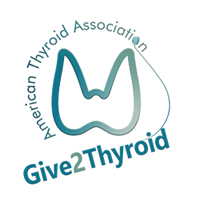ABBREVIATIONS & DEFINITIONS
 Papillary thyroid cancer: the most common type of thyroid cancer. There are 4 variants of papillary thyroid cancer: classic, follicular, tall-cell and noninvasive follicular thyroid neoplasm with papillary-like nuclear features (NIFTP).
Papillary thyroid cancer: the most common type of thyroid cancer. There are 4 variants of papillary thyroid cancer: classic, follicular, tall-cell and noninvasive follicular thyroid neoplasm with papillary-like nuclear features (NIFTP).
Cancer metastasis: spread of the cancer from the initial organ where it developed to other organs, such as the lungs and bone.
Thyroidectomy: surgery to remove the entire thyroid gland. When the entire thyroid is removed it is termed a total thyroidectomy. When less is removed, such as in removal of a lobe, it is termed a partial thyroidectomy.
Total thyroidectomy: surgery to remove the entire thyroid gland.
Thyroglobulin antibodies: these are antibodies that attack the thyroid instead of bacteria and viruses, they are a marker for autoimmune thyroid disease, which is the main underlying cause for hypothyroidism and hyperthyroidism in the United States.
Thyroglobulin: a protein made only by thyroid cells, both normal and cancerous. When all normal thyroid tissue is destroyed after radioactive iodine therapy in patients with thyroid cancer, thyroglobulin can be used as a thyroid cancer marker in patients that do not have thyroglobulin antibodies.
Radioactive iodine (RAI): this plays a valuable role in diagnosing and treating thyroid problems since it is taken up only by the thyroid gland. I-131 is the destructive form used to destroy thyroid tissue in the treatment of thyroid cancer and with an overactive thyroid. I-123 is the non-destructive form that does not damage the thyroid and is used in scans to take pictures of the thyroid (Thyroid Scan) or to take pictures of the whole body to look for thyroid cancer (Whole Body Scan).
Thyroid Remnant Ablation: destruction of the small amount of thyroid tissue that remains after surgery (thyroidectomy) with the use of radioactive iodine.
Recombinant human TSH (rhTSH): human TSH that is produced in the laboratory and used to produce high levels of TSH in patients after an intramuscular injection. This is mainly used in thyroid cancer patients before treating with radioactive iodine or performing a whole body scan. The brand name for rhTSH is Thyrogen™.
Thyroid Hormone Withdrawal (THW): this is used to produce high levels of TSH in patients by stopping thyroid hormone pills and causing short-term hypothyroidism. This is mainly used in thyroid cancer patients before treating with radioactive iodine or performing a whole body scan.
Lymph node: bean-shaped organ that plays a role in removing what the body considers harmful, such as infections and cancer cells.
Cancer recurrence: this occurs when the cancer comes back after an initial treatment that was successful in destroying all detectable cancer at some point.
Clinical trials: when a new drug is developed, it must undergo an extensive series of steps, called phases, to prove that it is more effective in patients than the drugs that are currently available to treat the condition. A Phase I trial tests a new drug or treatment in a small group of people for the first time to evaluate its safety, determine a safe dosage range and identify side effects. A Phase II trial gives the drug to a larger group of people to see if it is effective and to further evaluate its safety. A Phase III trial gives the drug to large groups of people to confirm its effectiveness, monitor side effects, compare it to commonly used treatments and collect information that will allow the drug or treatment to be used safely.




